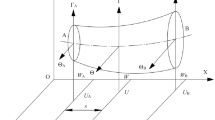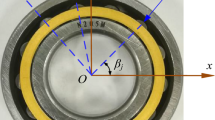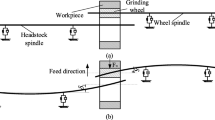Abstract
Crankshaft is a core part of automobile engine to bear impact load and transmit power. Precision grinding is the most important machining method to achieve high precision of crankshaft main journal. Although many scholars have established various simulation models in the field of cylindrical grinding, it is difficult to carry out effective quantitative simulation for a given crankshaft main journal grinding system. Aiming at the shortcomings of the existing models, a double-rotor dynamic model is proposed, which considers the interaction between the grinding wheel and the main journal, and iterative algorithm is adopted to simulate material removal and roundness change in the grinding process of the main journal. The normal force between grinding wheel and the main journal is defined in detail in the algorithm, which is closer to the actual grinding process. For a given crankshaft grinding system, different grinding strategies of the main journal are quantitatively simulated by using the model. The proposed model and algorithm are validated by experiments, which can provide a basic model for the further study of the crankshaft cylindrical grinding system.











Similar content being viewed by others
Data availability
Not applicable.
References
Jianhua W (2012) Automobile engine theory. National Defense Industry Press, Beijing
Liqiang D, Xueping Z, Zhenqiang Y (2013) A method to control the deformation of main journals in grinding process. Mach Des Res 29(3):66–69. https://doi.org/10.13952/j.cnki.jofmdr.2013.03.005
Yucan F, Lin T, Jiuhua X (2015) Development and application on the grinding process modeling and simulation. J Mech Eng 51(7):197–205. https://doi.org/10.3901/JME.2015.07.197
Rudrapati R, Pal PK, Bandyopadhyay A (2016) Modeling and optimization of machining parameters in cylindrical grinding process. Int J Adv Manuf Technol 82(9-12):2167–2182. https://doi.org/10.1007/s00170-015-7500-9
Fricker DC, Speight A, Pearce TRA (2006) The modelling of roundness in cylindrical plunge grinding to incorporate wave shift and external vibration effects. Proc Inst Mech Eng B J Eng Manuf 220(8):137–1358. https://doi.org/10.1243/09544054JEM509
Pearce TRA, Fricker DC, Speight A (2007) Indirect measurement of grinding wheel run-out using acoustic emission. Int J Manuf Technol Manag 33(12):139–154. https://doi.org/10.1504/IJMTM.2007.014147
Pearce TRA, Flicker DC, Speight A (2007) The effect on workpiece roundness of the run-out of CBN electroplated grinding wheels. Key Eng Mater 329:483–488. https://doi.org/10.4028/www.scientific.net/KEM.329.483
Weck M, Alldieck J (1989) The originating mechanisms of wheel regenerative grinding vibration. CIRP Ann Manuf Technol 38(1):381–384. https://doi.org/10.1016/S0007-8506(07)62728-0
Wang LP, Wang D, Wang B (2019) An analysis method of oscillating grinding motion model for crankshaft pin journal. IEEE Access 7:137163–137171. https://doi.org/10.1109/ACCESS.2019.2942080
Chiu N, Malkin S (1993) Computer simulation for cylindrical plunge grinding. Ann Manuf Technol 42(1):383–387. https://doi.org/10.1016/s0007-8506(07)62467-6
Saglam H, Unsacar F, Yaldiz S (2005) An experimental investigation as to the effect of cutting parameters on roundness error and surface roughness in cylindrical grinding. Int J Prod Res 43(11):2309–2322. https://doi.org/10.1080/00207540412331330110
Saglam H, Yaldiz S, Unsacar F (2007) The effect of tool geometry and cutting speed on main cutting force and tool tip temperature. Mater Des 191(28):101–111. https://doi.org/10.1016/j.matdes.2005.05.015
Leonesio M, Parenti P, Cassinari A, Bianchi G, Monno M (2012) A time-domain surface grinding model for dynamic simulation. Procedia CIRP 4(1):166–171. https://doi.org/10.1016/j.procir.2012.10.030
Yang Y, Lin J, Xu S (2012) Surface grinding machine stability characteristics limited prediction. Mech Eng Res 2(2). https://doi.org/10.5539/mer.v2n2p114
Cui Q, Ding H, Cheng K (2015) An analytical investigation on the workpiece roundness generation and its perfection strategies in centerless grinding. Proc Inst Mech Eng B J Eng Manuf 229(3):513–518. https://doi.org/10.1177/0954405414530899
Jinglong S, Fei Q, Pei C, Tong A (2016) A predictive model of grinding force in silicon wafer self-rotating grinding. Int J Mach Tools Manuf 109:74–86. https://doi.org/10.1016/j.ijmachtools.2016.07.009
Li B, Dai C, Ding W, Yang C, Shumyacher V (2020) Prediction on grinding force during grinding powder metallurgy nickel-based superalloy fgh96 with electroplated CBN abrasive wheel. Chin J Aeronaut. https://doi.org/10.1016/j.cja.2020.05.002
Xi X, Ding W, Wu Z, Anggei L (2020) Performance evaluation of creep feed grinding of γ-TiAl intermetallics with electroplated diamond wheels. Chin J Aeronaut. https://doi.org/10.1016/j.cja.2020.04.031
Azizi A, Mohamadyari M (2015) Modeling and analysis of grinding forces based on the single grit scratch. Int J Adv Manuf Technol 78(5-8):1223–1231. https://doi.org/10.1007/s00170-014-6729-z
Jiang J, Ge P, Sun S, Wang D, Wang Y, Yang Y (2016) (2016) From the microscopic interaction mechanism to the grinding temperature field: an integrated modelling on the grinding process. Int J Mach Tool Manu 110:27–42. https://doi.org/10.1016/j.ijmachtools.2016.08.004
Zhu W, Yang Y, Li HN, Axinte D, Beaucamp A (2019) Theoretical and experimental investigation of material removal mechanism in compliant shape adaptive grinding process. Int J Mach Tools Manuf 142:76–97. https://doi.org/10.1016/j.ijmachtools.2019.04.011
Wanli X, Wenxiang D, Jianhua C, Lianggang Z, Wenbiao S (2020) A novel double rotor coupling model for inner bore grinding process. Int J Adv Manuf Technol 106(7-8):3357–3366. https://doi.org/10.1007/s00170-019-04873-x
Wanli X, Jianhua C, Wenxiang D, Xu Z (2019) Dual-rotor coupling model and simulation algorithm for round journal grinding process. J Mech Eng 55(11):170–177. https://doi.org/10.3901/JME.2019.21.170
Wenbo B, Quan B, Haiyan L (2015) Fundamentals of vibration mechanics and Matlab Application. Tsinghua University Press, Beijing
Shengyi L, Yifan D (2007) In-position detection and error separation technology for precision and ultra-precision machining. National University of Defense Technology Press, Changsha
Jin L, Yan Z, Xie L, Gou W, Tang L (2014) An experimental investigation of spindle rotary error on high-speed machining center. Int J Adv Manuf Technol 70(1-4):327–334. https://doi.org/10.1007/s00170-013-5270-9
Anandan KP, Ozdoganlar OB (2013) An LDV-based methodology for measuring axial and radial error motions when using miniature ultra-high-speed (UHS) micromachining spindles. Precis Eng 37(1):172–186. https://doi.org/10.1016/j.precisioneng.2012.08.001
Acknowledgements
The authors gratefully acknowledge the financial support of the National Natural Science Foundation of China (No.51575173) and the Science and Technology Major Project-Advanced NC Machine Tools & Basic Manufacturing Equipment (No: 2016ZX04003001).
Funding
This work was financially supported by the National Natural Science Foundation of China (No.51575173) and the Science and Technology Major Project-Advanced NC Machine Tools&Basic Manufacturing Equipments (No: 2016ZX04003001).
Author information
Authors and Affiliations
Contributions
Xu Zeng performed the experiments, made the simulation, and wrote the manuscript, while Wanli Xiong contributed to the conception of the study and helped perform the analysis with constructive discussions, Wenbiao Sun helped perform the analysis with constructive discussions, and Hongyan Ye and Zhiyong Tang helped perform the experiments.
Corresponding author
Ethics declarations
Ethical approval
There was no ethical issue in this project.
Consent to participate
There were no participants in this project.
Consent to publish
The authors are the owner of the data in this project and have consent to publish.
Competing interest
The authors declare no competing interests.
Additional information
Publisher’s note
Springer Nature remains neutral with regard to jurisdictional claims in published maps and institutional affiliations.
Rights and permissions
About this article
Cite this article
Zeng, X., Xiong, W., Sun, W. et al. Research on double-rotor dynamic grinding model and simulation algorithm for crankshaft main journal. Int J Adv Manuf Technol 114, 3391–3400 (2021). https://doi.org/10.1007/s00170-021-06761-9
Received:
Accepted:
Published:
Issue Date:
DOI: https://doi.org/10.1007/s00170-021-06761-9




